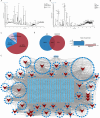Integrative network pharmacology, transcriptomics, and proteomics reveal the material basis and mechanism of the Shen Qing Weichang Formula against gastric cancer
- PMID: 40155922
- PMCID: PMC11954191
- DOI: 10.1186/s13020-025-01091-4
Integrative network pharmacology, transcriptomics, and proteomics reveal the material basis and mechanism of the Shen Qing Weichang Formula against gastric cancer
Abstract
Background: Gastric cancer (GC) is a common malignancy with poor prognosis and lack of efficient therapeutic methods. Shen Qing Weichang Formula (SQWCF) is a patented traditional herbal prescription for GC, but its efficacy and underlying mechanism remains to be clarified.
Purpose: To explore the efficacy and potential mechanism of SQWCF in treating GC.
Methods: A subcutaneous transplantation tumor model of human GC was established for assessing SQWCF's efficacy and safety. A comprehensive strategy integrating mass spectrometry, network pharmacology, omics analysis, and bioinformatic methods was adopted to explore the core components, key targets, and potential mechanism of SQWCF in treating GC. Molecular docking, immunohistochemistry, quantitative real-time PCR, and western blot were applied to validation.
Results: In the mouse model of GC, SQWCF effectively suppressed the GC growth without evident toxicity and enhanced the therapeutic efficacy of paclitaxel. Network pharmacology and molecular docking based on mass spectrometry showed that key targets (CASP3, TP53, Bcl-2, and AKT1) and core active components (Calycosin, Glycitein, Liquiritigenin, Hesperetin, and Eriodictyol) involved in the anti-GC effect of SQWCF had stable binding affinity, of which AKT1 ranked the top in the affinity. Validation based on network pharmacology and omics analysis confirmed that PI3K-AKT and MAPK signaling pathways, as well as downstream apoptosis pathway, explained the therapeutic effects of SQWCF on GC. In addition, family with sequence similarity 81 member A (FAM81A) was identified as a novel biomarker of GC that was aberrantly highly expressed in GC and associated with poor prognosis by bioinformatic analysis, and was an effector target of SQWCF at both mRNA and protein levels.
Conclusion: This study uncovers a synergistic multi-component, multi-target, and multi-pathway regulatory mechanism of SQWCF in treating GC comprehensively, emphasizing its potential for therapeutic use and providing new insights into GC treatment.
Keywords: Apoptosis; Gastric cancer; MAPK signaling pathway; Network pharmacology; PI3K-AKT signaling pathway; Paclitaxel; Proteomics; Shen Qing Weichang formula; Transcriptomics.
© 2025. The Author(s).
Conflict of interest statement
Declarations. Conflict of interest: The authors declare that they have no known competing financial interests or personal relationships that could have appeared to influence the work reported in this paper. Ethics approval and consent to participate: The animal study protocol was approved by the Experimental Animal Ethics Committee of Shanghai University of Traditional Chinese Medicine (Approval Document: PZSHUTCM2304100001). Consent for publication: Not applicable.
Figures









References
-
- Thrift AP, Wenker TN, El-Serag HB. Global burden of gastric cancer: epidemiological trends, risk factors, screening and prevention. Nat Rev Clin Oncol. 2023;20(5):338–49. - PubMed
-
- Shitara K, Ohtsu A. Advances in systemic therapy for metastatic or advanced gastric cancer. J Natl Compr Canc Netw. 2016;14(10):1313–20. - PubMed
Grants and funding
- ZYYCXTD-C-202208/Program for Innovation Team Building at Institutions of Higher Education in Chongqing Municipality
- 31801153/National Outstanding Youth Science Fund Project of National Natural Science Foundation of China
- 21MC1930500/Collaborative Innovation Center for Modern Science and Technology and Industrial Development of Jiangxi Traditional Medicine
LinkOut - more resources
Full Text Sources
Research Materials
Miscellaneous

